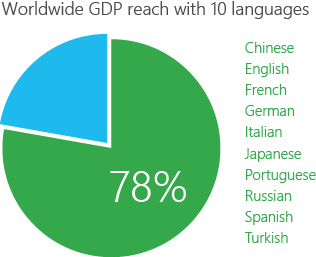Readiness & training
Provide sales, marketing, technical, or human resources content and training
Internal content is created faster than it is humanly possible to translate for all your internal stakeholders, as well as key partners, customers, and distributors.
A study conducted by Microsoft showed that more than 95% of pages created on internal company sites are never translated beyond their initial publishing language. For the less than 5% of sites that are translated, the translation is limited to one or, at most, two additional languages.

By translating content into just the world’s top 10 languages, this study estimated that a company will, on average, cover almost 78% of its business footprint. Even by only supporting the top 5 languages, a business will be able to reach more than 60% of its global footprint.
This is true whether the content is:
- Training material for customer-support or field teams.
- Sales or partner readiness tools such as manuals, presentations, collateral, and training materials.
- Human-resources communications.
- R&D internal research papers.
Any area where knowledge-sharing needs to reach employees or partners in a language other than their own, machine translation is the only economically viable solution to scale across your organization’s communication channels.
Learn more about machine translation and how Translator works.
Translator offers a broad set of options to allow customers to integrate machine translation across all these communications channels. In addition, Translator lets users customize text translations. Custom Translator allows you to build unique, industry-specific language models.
Expand the sections below to learn more on how to use Translator for your readiness needs.
There are multiple ways to integrate translation functionality into your SharePoint sites. SharePoint supports a native and integrated multi-language support model through the concept of SharePoint site variation. It also offers native machine translation APIs, powered by Translator, that can be integrated into any SharePoint application.
Whether information is shared through a standard website or a more advanced online application, it is equally straightforward to integrate machine translations into the user experience.
Translator offers access to a set of open web APIs that can be seamlessly integrated into these online applications. From a user standpoint, translation is a feature accessible within an application. From an enterprise standpoint, the application administrator can control the various aspects of the translations, for example, available languages, or enablement of customization.
With Translator, application developers can seamlessly integrate translation across the application experience, from development to multilingual apps. Through the use of the Multilingual App Toolkit (MAT), developers can easily produce multilingual applications straight from Visual Studio, at no cost.
Translator can also be integrated into an application as a plug-in feature to extend the capabilities of the application. Examples include translation memory applications offered by independent software vendor (ISV) partners and Adobe Experience Manager.
Lastly, at an application level, developers can opt to leverage Translator directly in their applications to manage on-the-fly or server-side translations.




